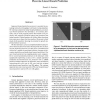ASPLOS
1994
ACM
14 years 4 months ago
1994
ACM
Several researchers have proposed algorithms for basic block reordering. We call these branch alignment algorithms. The primary emphasis of these algorithms has been on improving ...
MICRO
1994
IEEE
14 years 4 months ago
1994
IEEE
High performance architectures have always had to deal with the performance-limiting impact of branch operations. Microprocessor designs are going to have to deal with this proble...
ISCA
1993
IEEE
14 years 4 months ago
1993
IEEE
Recent attention to speculative execution as a mechanism for increasing performance of single instruction streams has demanded substantially better branch prediction than what has...
ASPLOS
1996
ACM
14 years 4 months ago
1996
ACM
Branch prediction is an important mechanism in modern microprocessor design. The focus of research in this area has been on designing new branch prediction schemes. In contrast, v...
MICRO
1996
IEEE
14 years 4 months ago
1996
IEEE
Branch prediction is the predominant approach for minimizing the pipeline breaks caused by branch instructions. Traditionally, branch prediction is accomplished in one of two ways...
HPCA
1997
IEEE
14 years 4 months ago
1997
IEEE
This paper introduces a new architectural approach that supports compiler-synthesized dynamic branch predication. In compiler-synthesized dynamic branch prediction, the compiler g...
MICRO
1998
IEEE
14 years 4 months ago
1998
IEEE
To achieve highly accurate branch prediction, it is necessary not only to allocate more resources to branch prediction hardware but also to improve the understanding of branch exe...
ISCA
1998
IEEE
14 years 4 months ago
1998
IEEE
Branch prediction has enabled microprocessors to increase instruction level parallelism (ILP) by allowing programs to speculatively execute beyond control boundaries. Although spe...
PLDI
2005
ACM
14 years 6 months ago
2005
ACM
Code placement techniques have traditionally improved instruction fetch bandwidth by increasing instruction locality and decreasing the number of taken branches. However, traditio...
ISCA
2005
IEEE
14 years 6 months ago
2005
IEEE
Improved branch prediction accuracy is essential to sustaining instruction throughput with today’s deep pipelines. We introduce piecewise linear branch prediction, an idealized ...


